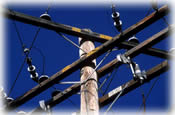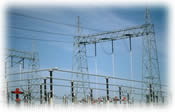
Grades 9-12

Don't have an account yet? Sign up for free
Don't have an account yet? Sign up for free

It’s easy to take energy for granted. But stop and think for a minute. Energy is the power used to make things work. Energy:
Energy:
Fossil fuels including coal, oil and natural gas are a major source of energy. Found underground, fossil fuels are made from compressed bodies of animals and plants that died long ago. Fossil fuels are limited and nonrenewable resources – once these resources are gone, there will never be any more.
Some people believe there will be a time in the future when it will be possible to eliminate our dependence on fossil fuels by harnessing the power of the sun, water, wind, and other alternatives. But there is no guarantee this will happen. It is also not known how long it might take for this to happen. Saving energy means using energy resources wisely so some resources will be left for people in the future.
Saving energy also means saving money. Dwindling supply relative to demand has increased prices at the gas pump as well as the fuels for home heating. Given that fossil fuel-fired generators are the source of much of our electricity, there has been a ripple effect on electricity bills. Higher market prices are serving as an economic incentive for people to reduce energy consumption. Government programs in the form of taxes and subsidies serve as additional incentives for saving energy.
One of your tasks is to identify energy alternatives that use “people power”. You will also compute the operating costs of a major appliance, and you will play the role of a well-informed consumer– choosing the best deal on an appliance after considering both the price of the appliance and its lifetime operation costs. Finally, you will explore ways in which economic incentives can influence a person’s energy choices.
Activity 1: People Power
 Think of all the things you do during a day that require energy in the form of fossil fuel or electricity. Sometimes you can save this energy by substituting people power. Play this Energy Conservation Game to learn more about people-powered alternatives. On the left side of the page is a set of twelve items. Each item is something that uses fossil fuel or electricity. On the right side is a set of twelve more items that use people-powered alternatives. Match the energy-using devices on the left with the energy-saving alternatives on the right to find an alternative to fossil fuel energy.
Think of all the things you do during a day that require energy in the form of fossil fuel or electricity. Sometimes you can save this energy by substituting people power. Play this Energy Conservation Game to learn more about people-powered alternatives. On the left side of the page is a set of twelve items. Each item is something that uses fossil fuel or electricity. On the right side is a set of twelve more items that use people-powered alternatives. Match the energy-using devices on the left with the energy-saving alternatives on the right to find an alternative to fossil fuel energy.
Play the Energy Conservation Game to learn about conserving energy.
Activity 2: Energy-Efficient Appliances
Another way to save energy is to buy products that are energy-efficient—in other words, products that do the same job using less energy. To help consumers compare the energy efficiency of major home appliances, the federal government requires the posting of a yellow and black Energy Guide on a select group of appliances including refrigerators, freezers, clothes washers, dryers, dishwashers, air conditioners, furnaces and water heaters. An Energy Guides gives consumers the estimated annual cost of operating an appliance, or a standardized energy efficiency ratio for similar appliances. Use this sample of an Energy Guide for a refrigerator-freezer to answer the following questions in the interactive activity.
Activity 3: Government Incentives
In the United States, a broad range of federal, state and local government programs encourage consumers to conserve energy. Many of these programs depend on economic incentives to influence people’s behavior. Positive incentives reward people for taking a specific action while negative incentives discourage behaviors through some kind of penalty.
Several examples of government programs that encourage people to save energy are provided below. Can you distinguish the positive from the negative incentives?
Now, complete this interactive activity. View Interactive ActivityOnce you have completed the activity, on a sheet of paper summarize how these economic incentives influence energy conservation:
You will then discuss your answers with your teacher.
While some resources are renewable, fossil fuels are not. When these fuels are gone, they are gone. To make sure there will be some fossil fuels for the future, people must conserve energy. Some people do this just because they think it is the right thing to do. Others conserve because of economic incentives. Higher energy prices caused by diminishing supplies are a naturally occurring market incentive. Government also provides incentives in the form of taxes and subsidies. What motivates you to be an energy saver?
will be some fossil fuels for the future, people must conserve energy. Some people do this just because they think it is the right thing to do. Others conserve because of economic incentives. Higher energy prices caused by diminishing supplies are a naturally occurring market incentive. Government also provides incentives in the form of taxes and subsidies. What motivates you to be an energy saver?
While some resources are renewable, fossil fuels are not. When these fuels are gone, they are gone. To make sure there will be some fossil fuels for the future, people must conserve energy. Some people do this just because they think it is the right thing to do. Others conserve because of economic incentives. Higher energy prices caused by diminishing supplies are a naturally occurring market incentive. Government also provides incentives in the form of taxes and subsidies. What motivates you to be an energy saver?
JUST FOR FUN (MORE INFORMATION)
Conduct a home energy audit. An interactive online audit source is:
http://hes.lbl.gov/consumer/
https://www.energystar.gov/
Background on a voluntary federal program that awards certain products the Energy Star for energy efficiency. This site also provides information to help consumers identify, locate, and purchase energy-efficient appliances.
https://www.fueleconomy.gov/
Data on miles per gallon of gasoline used by vehicles manufactured from 1985 to the present.
https://www.fueleconomy.gov/feg/taxcenter.shtml
Offers information on tax breaks for purchasers of the new hybrid gas/electric vehicles.
The Weatherization Assistance Program
For low-income households which funds energy audits and home improvements that increase energy efficiency.

Grades 9-12

Grades 9-12

Grades 9-12

Grades 9-12
